4 Learning for all in an excellent learning environment

Figure 4.1
For us, differentiation is about giving all the students challenges on each their level in interaction in the same classroom, in a common class environment.
Input from teachers
This report clearly shows the importance of creating an excellent learning environment for all students, including those with higher learning potential. “Excellent” is used about something that is especially good and has first-rate quality. The Committee believes it is particularly important for students with higher learning potential that the learning environment is challenging but supportive, and that the teachers motivate them and satisfy their learning needs and abilities.
The Committee is aware that the learning environment is in constant development and affected by the people who constitute the learning environment at any point in time. An excellent learning environment is the benchmark that schools must judge themselves by for – virtually a “gold standard” – but it is not a given that everyone will reach this standard. There is a need to develop a common understanding and ownership of the goals and expectations for the work with students' learning. Schools must assess their own practice and status, which means ascertaining strong sides they want to continue building on, and areas they want to develop. This demands a coordinated and concentrated collaboration on some basic principles which first and foremost are realised by teachers and school leaders, but which also require support from school owners, the PPS and other cooperation partners.
“Learning environment” is a concept that is used in many ways in research literature and state programmes. One popular definition is “the environmental factors in school that impact the social and academic learning of the students, as well as their general situation in the everyday school”.1 This definition fits well with how the Committee considers the concept of learning environment, but we also want to describe some principles and measures schools should focus on if students with higher learning potential are to have a better school programme. An excellent learning environment should be student-focused, consider the variations in the student group, their different ways of learning and individual differentiation needs.2
4.1 Learning – interaction between inheritance and environment
There are different views on and theories about learning. Many theories focus almost exclusively on the individual and personal cognitive qualities, while others (especially in recent years) have insisted that social and cultural circumstances impact learning the most.3 The Committee prefers to consider learning from a perspective where inheritance, growth, environment, the individual, cognition and social factors are not only compatible but indivisible. Plasticity as a construct and phenomenon illuminates the interaction between individual, identity, inheritance, environment, experience and social circumstances. Empirical studies in brain research have increasingly supported the idea that learning in many ways is manifested between brain cells.4 Learning may lead to connections between cells being created or broken, reinforced or reduced. Even small changes in this connecting process may impact memory and learning in dramatic ways. Synaptic plasticity refers precisely to this quality of the brain which enables it to continually create new connections and change the balance between existing connections.5
Once connections are first established, there is no guarantee that they will remain in place for the rest of a person's life. New experiences, traumas, negative experiences or illness may all contribute to a form of “destructive” plasticity where previously established connections are weakened or disappear, and where the very capacity for activity and plasticity in the brain is reduced.6 Thus a view of learning as growth based on the fact that everybody can learn and develop their abilities is important.7 This is also consistent with the international trend which involves moving from a view of the strong abilities of this student group as inherited and stable, to a view where one see the skills of students as influenced by effort and work, and where abilities in themselves may be modified over time by experiences.8 Moreover, so-called non-cognitive or social and emotional skills, such as stamina, cooperative ability, curiosity and the ability to work with dedication and deal with setbacks can be developed and learnt. These are skills of great importance for students' learning and future social and working life.9
Textbox 4.1 Finnish teachers' understanding of how students with higher learning potential learn
A study of what Finnish teachers believe when it comes to whether giftedness is inherent or a property that can be developed showed differing opinions. Some teachers believed that giftedness is something these students “have” – a special form of knowledge, ability and skills, i.e. something they are born with rather than something that can be shaped and developed. Some suggested that it is implied in the name – gifted students have a “gift”. When the teachers spoke about giftedness as something that can be developed, they were referring to cognitive functions: The students learn things easily and quickly (take in things quickly), it is “natural” for them, or they do not need to practice, and so on. The teachers described the students as good at problem solving, creative and innovative, able to think new thoughts, enthusiastic, eager to learn, motivated, interested, independent, brave, open and questioning.
Source Børte et al. 2016
One way of understanding the complex interaction between inheritance and environment is to use Renzulli's10 three-ring model of giftedness, which Mönks11 later has developed by adding three social areas: family, peers and school. This is called the multifactor model. Only when there is an optimal interaction with follow-up and stimulation between these six factors will students with higher learning potential have the opportunity to develop this potential, which will be expressed as extraordinary achievements in one or more areas.12 Mönks' multifactor model is presented in Figure 4.2.
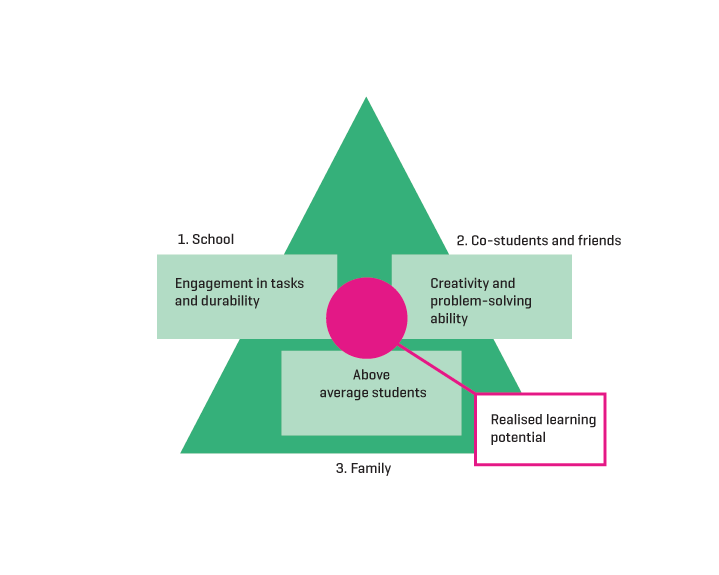
Figure 4.2 Requirements for realising learning potential
The figure is inspired by Skogen and Smedsrud's presentation (2016) of Mönks' multifactor model
This model can be used to illustrate characteristic features of students with higher learning potential. The first area refers to exceptional abilities. This term means students can typically abstract, adapt to new situations, collect information quickly and accurately and use it in specific subject areas by distinguishing relevant from irrelevant information. Competence in problem solving with advanced use of knowledge and strategies is also highlighted as an important characteristic.13
The second area is creativity and the ability to solve problems. Creativity is described as students displaying curiosity, originality, inventiveness and willingness to take risks – and at the same time challenging conventions and traditions. The third area is called task motivation and stamina. Motivation connects to qualities that can be developed, such as stamina, decisiveness, strength of will and positive energy.14 The three areas shown in this model are consistent with characteristics of students on higher and advanced levels in international studies, such as PISA.15
The opportunity students have to develop their learning potential optimally depends on the interaction between the factors featured in this model. A student will have his or her learning potential realised if provided with creative methods and challenging tasks. The surroundings, i.e. the learning environment, will play a decisive role for whether the student will be acknowledged and seen.16 The Committee therefore wishes to outline some core elements included in what the report calls an excellent learning environment, see Figure 4.3.
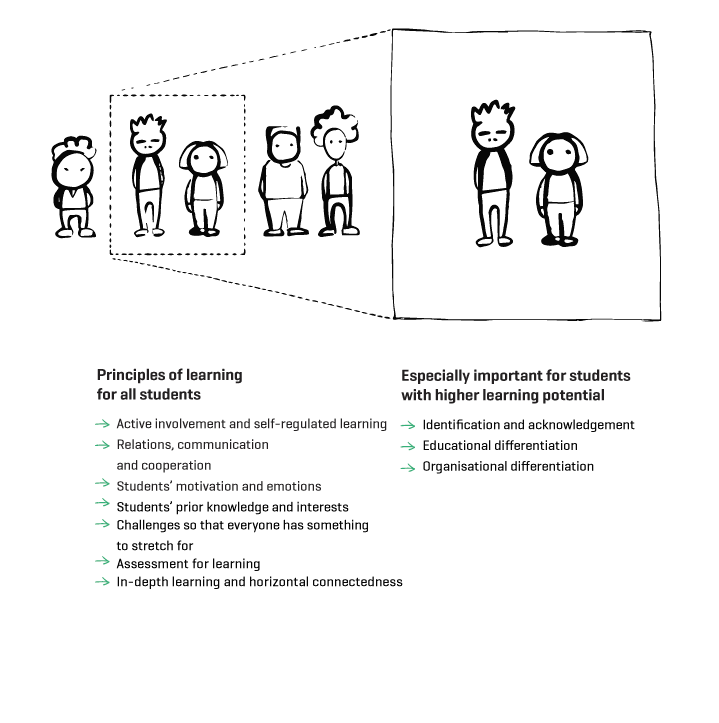
Figure 4.3 Excellent learning environment
Creating an excellent learning environment is not the responsibility of the teachers alone. It requires systematic work with learning on all levels through professional cooperation.17 The school leaders are responsible for having goals and ambitions, and for creating a good and functional organisation. Good leadership will ensure that the employees have the opportunity to work in a positive and systematic way with the variations in the student group, with their different ways of learning and individual differentiation needs.18
Students who are active in their own learning process need teachers, school leaders, school owners (local/county authorities), PPS and homes that cooperate on improving the quality of the instruction. This is described in Chapter 7.
4.2 Principles of learning
Students with higher learning potential have different needs and aptitudes which will impact how they learn and how they are motivated. For this reason, the Committee has decided to present seven principles of learning,19 which constitute the grounds for a good learning environment and good teaching for the learning of all students, including those with higher learning potential, see Figure 4.4. Input received by the Committee shows that several of the principles are particularly important for motivating students with higher learning potential, but that it can be demanding to implement the principles in practice.
Learning is promoted when the school and the teachers see the importance of and systematically work with:
Learners at the centre (co-participation and self-regulated learning)
Social nature of learning (relations, communication and cooperation)
Student's motivation and emotions are integral to learning
Students' prior knowledge and interests
Stretching all students
Assessment for learning
In-depth and interdisciplinary learning
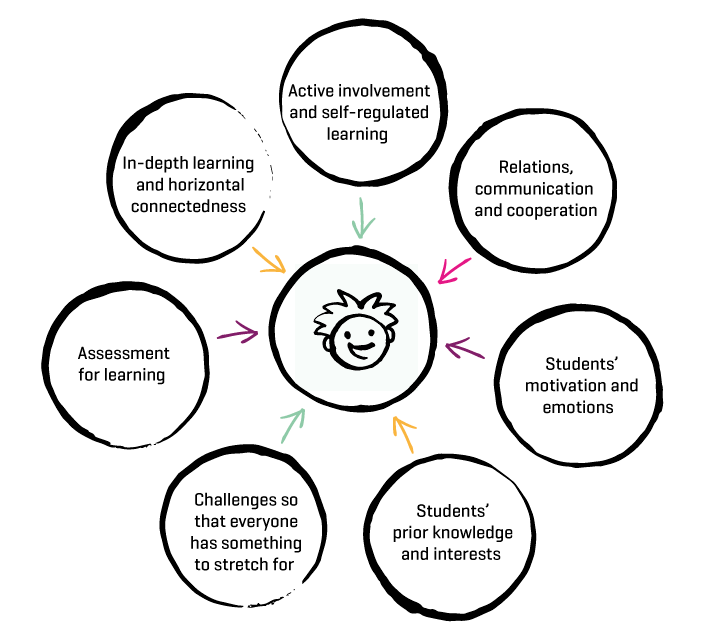
Figure 4.4 Principles of learning
The Committee points out that in every situation there may be more factors than these which determine whether teaching and learning activities lead to learning for the students. There are examples of student activities, cooperation and feedback that do not promote learning. There are also circumstances that directly counteract learning, for example if the students feel unsafe or are afraid. Following up student progression and development is therefore a key element when working on learning. Methods can have good intentions without necessarily leading to learning and motivation for the students. The seven principles in Figure 4.4 must be considered in relation to each other, but will be influenced in various ways by the learning environment they are a part of.20 The abilities and needs of the students must also be connected closely to how the schools work with the principles. Knowledge about the characteristics of students with higher learning potential is thus necessary for positive work with the seven principles of learning for this group of students.
4.2.1 Co-participation and self-regulated learning
We need to learn how to learn, self-regulation, study techniques, learning strategies, this must be learnt earlier – at once. The meaning of learning must be explained so that we can set ourselves goals.
Input from students
Student co-participation is highlighted in the principles of learning, and this means taking part in decisions that refer to learning for each individual and on behalf of the whole group. The students must participate in planning, implementation and assessment of the instruction. How much and how the students participate will vary according to age and development levels, and require knowledge about alternative choices and their possible consequences. The work with the subjects will lead the students in different ways to become acquainted with their own abilities and talents. This will give them a better basis for co-participating and making deliberate choices.21
Student co-participation is also one of several principles of good formative assessment.22 Co-participation in the learning activities, combined with guidance and well-structured instruction, is important for the students' motivation.23 By involving the students actively in assessment processes, using for example goals and feedback, they will improve in reflecting on their own learning and identifying where they are in their own learning process. Hence, the students do not only become aware of what they learn, but also how they learn.24
Insight into one's own learning and thought processes and skills requires metacognition and self-regulated learning. Metacognition is about monitoring and using knowledge and strategies to regulate thinking and problem solving.25 Self-regulated learning means that students are able to coordinate, evaluate and optimise knowledge and skill-based factors to reach their learning goals. This includes motivation, knowledge about strategies and one's own thought processes.26
Metacognition and self-regulation are important for learning and can be developed in interaction with teachers and co-students. By developing metacognition and self-regulation, the students learn to involve themselves in the learning process in a manner consistent with promoting in-depth learning. This may have many positive effects on stamina and on the plans for the work on learning. This may also contribute to strengthening the students' motivation for further learning and give them a positive perception and experience of their own mastering.27
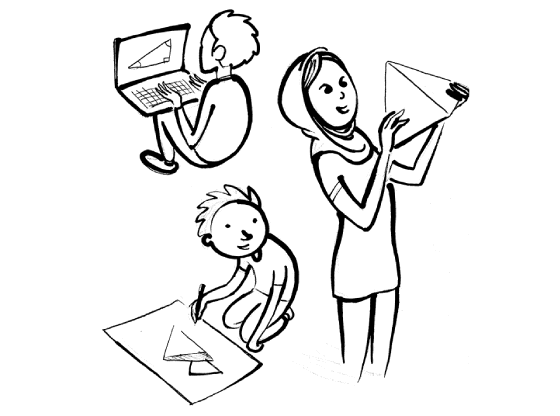
Figure 4.5
An important part of being self-regulated is being aware of different learning strategies and being able to choose appropriate strategies for the tasks the students must solve. Teachers may obtain insight into the students' mental processes by talking with them about how they have approached particular tasks. Such dialogues may give teachers and students alike insight into how the student learns.28
Students with higher learning potential often typically have good stamina and are good at problem-solving strategies. They have the ability to work with advanced and more creative tasks.29 Improvisation and repetition may be reasons why students feel that the teaching is boring and not challenging enough.30 The students need to master the use learning strategies and regulate their own learning to exploit their own potential. If they do not have this knowledge, the students might underachieve. Therefore, students must understand how they learn and what motivates them.31
4.2.2 Relations, communication and cooperation
Teachers make a huge difference. A teacher can change everything for a student, your whole life can be changed. Make us suddenly manage things, turn poor patterns into good ones. The effort of a single teacher can make us enjoy school. Teachers are gold in our lives when they are good.
Input from SkoleProffene
The word “relation” stems from relatio, which refers to the contact between two persons. The quality of the interaction, and thus also the quality of the learning process, is therefore linked to how the student relates to his or her surroundings.32
The relationship between teacher and student is often pointed out as the factor having the greatest impact on the learning outcome.33 Relations are also highlighted as one of the two key competence areas for creating a learning environment of good quality where the students experience well-being and develop academically. The second competence area is being a clear leader.34 A warm and supportive teacher positively impacts how the students accept each other. This may in turn influence individual student learning outcome. For students with challenges, the quality of the relationship between teacher and student has even more importance. It is important that the students feel their teacher is confident and cares about each of them, and that the instruction supports student involvement, motivation and academic development.35 School leaders also play an important role by creating a learning environment where teachers feel respected, and where the students experience that the teacher cares about them and their learning.36
A lack of or poor relations to teachers may explain the non-completion rate among students with higher learning potential.37 They need the teachers to accept and understand them. Students state that it is important that the teacher knows his or her students well, and wonders why they do as they do. Many students explain that what school today calls behaviour is actually their way of expressing how they are doing. Therefore, it is vital to have teachers who dare to investigate what underlies the behaviour, and who wants to understand the students. Students with higher learning potential have many ways of displaying or hiding their abilities, and the teacher will discover and understand them better by getting to know the students better. The students want teachers to cooperate with them on good ways of learning.38
Some students with higher learning potential may need to meet others of equal minds who think as they do, and who are on the same academic level. Students with higher learning potential do not necessarily have to have friends their own age. A characteristic of many children with higher learning potential39 in day care is that they enjoy communicating with the adult staff.40 The fact that students with higher learning potential may need to be with students on a higher level than their age group may at times challenge the social life in the school.41 Students with few or no friends often have a greater need to feel liked by their teacher.42
The Committee finds the cooperation between the home and the school to be an important condition when working on differentiated instruction for students with higher learning potential. Parents may be important in helping to identify the needs the student may have, and how he or she can best be motivated to learn.43 Schools with good cooperation with parents may gain better understanding of student needs and which academic strengths, challenges and interests may be used constructively in the learning activities. Parents may also cooperate with the school by giving courses on various topics, and organising trips and activities that reflect the interests of the students.44
The Committee has received much input from parents who feel that their child is not seen in school. They state that only once their child has been examined by the PPS for a learning or behaviour difficulty that the discovery is made that their child has strong cognitive abilities. Then the challenges may have already become quite large and the child may have developed unfortunate patterns that have had consequences for concentration and motivation.
Even though the home has great and important impact on the student's learning, it is important to be aware of the importance of school's input. It has been shown that in schools where the students experience the learning environment as positive, gender, parents' educational background and minority status have less to say for the learning results.45
4.2.3 Students' motivation and emotions
If things go slow, it's difficult to keep track, so many of us will tune out. Many of us get tired when we don't get to use our minds properly. If things are too slow, we don't learn anything, because we lose motivation. It quickly becomes boring and frustrating, and that may ruin much of our motivation to learn.
Input from SkoleProffene
Most students start school highly motivated to learn. This may particularly apply to students with higher learning potential. To maintain their motivation, the students need varied teaching and challenges, which students with higher learning potential do not always get. They may lose motivation and their interest in school, which may then have serious consequences.46
The importance of motivation for realising a student's learning potential is underlined in Report to the Storting no. 22 (2010–2011): “If students are to exploit their full potential for learning in school, it is decisive that they are willing and able to make an effort, and to use the resources that are available to them. Thus, the students' motivation for learning is quite decisive for their learning outcome. Motivation for learning can be defined as the motivation power behind efforts for learning”.47
It is customary to distinguish between internal and external motivation. Internal motivation refers to the student's interest in and desire to work with the school subjects. In contrast to external motivation, internal motivation is a driving force behind behaviour the individual wishes to express, even if it does not lead to any external reward or external consequences. When students have internal motivation, their action will be free from pressure, completely self-determined and raise competence. The activity, satisfactory in itself, is not influenced by what others will think of the performance, or the kind of reward that awaits when the task has been completed.48
Sports psychologists and coaches have considered requirements for good performance more than educational researchers, and they point to strength of will, stamina, impulse control and self-control as important capacities for exploiting one's own potential. These qualities are not constant and can be developed and learnt through training and guidance.49 In the sports environment, the following factors are viewed as important for developing good performances:
Having a concrete and easily understandable goal
Being able to maintain focus on this goal over time
Having a high level of self-discipline50
A requirement for realising these three factors is a high level of willpower and motivation which is continuously trained with the help of a coach. The first factor is having a concrete understanding of the desired goal. Furthermore, the performer must want to attain the goal, whether this is a football player or a student. Just as important as a good understanding of the main goal itself, is the development of sub-goals or targets the student can work towards, and where the student has the ability to assess goal satisfaction with the teacher or on his or her own.51
The second factor in this context is focus and stamina. In addition to being able to present strategies and basic knowledge, the teacher must be able to impart the importance of stamina and reward it. One of the main differences between students with high achievements and those who achieve on lower levels is the ability to never give up, but rather continue by trying new and more creative approaches until the task has been solved. Eventually, the joy of solving a problem will be sufficient reward, but along the way, the teacher must reward stamina and the student's work by defining and redefining the task itself.52
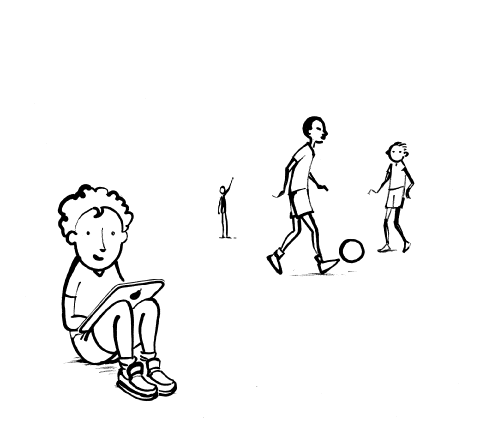
Figure 4.6
Willpower is a key factor in explaining self-control and impulse control. Self-control refers, for example, to how we manage to defer what we want to have here and now so we can achieve a reward in the future. Children who are struggling with their self-control in concrete situations may succeed if they have good strategies.53 Impulse control is very important for the exercise of self-control. Our impulses are the worst enemy of self-control, hence good impulse control is the first commandment for attaining good performance – regardless of what we are doing. Today many students have their focus interrupted due to frequent access to digital media, both at home and in school. In addition to such qualities as willpower and self-control, which are important for attaining good performance, the students' idea of how they learn is also an important factor.54
Several studies have pointed out that students with higher learning potential have higher internal motivation than other students.55 This fact notwithstanding, several of these students underachieve because they find that they are not academically included, or are not given the academic challenges they need. This may have consequences for their motivation.56 A learning environment that focuses on drawing on the interests of the students, and where they work well on learning objectives, will strengthen motivation and the wish to learn for students with higher learning potential who underachieve.57
4.2.4 Students' prior knowledge and interests
I was sitting a long time and working a bit chaotically with things that interested me in mathematics classes, because I often knew already what we were learning in class, but now when things are much more differentiated, I'm able to work logically towards a goal, which I think makes me learn more quickly than sitting and browsing through a book on my own.
Input from a student
The Norwegian comprehensive school has endeavoured to provide equal opportunities for all. The Committee asks whether this has prevented many students from receiving precisely what they need, because all children are different and have different needs and abilities. The individual differences are a complex interaction between sociocultural and personal factors. Sociocultural factors include parents' socio-economic status, educational background and aspects of the early-development and learning environment students have at home and in school. Personal factors include prior knowledge, learning strategies, motivation, the appetite to learn and ideas about one's own learning ability.58 These factors can also contribute to creating a learning culture with positive attitudes to learning. Analyses of PISA results in reading skills from 2009 indicate that few students experience that the teacher gives them support to link the content of the texts they read to prior knowledge and experiences. Nor do they experience that the teacher recommends books or authors they should read.59
Some students with higher learning potential may find that they have interests the school does not address in a way that motivates them. Connecting their experiences and areas of interest to the work with school subjects is therefore important and may contribute to strengthening motivation and acknowledging them.60 In the report, Det tenner en gnist! [Lighting a spark!] Dælien and Eriksen (2015) have studied the effect the elective subjects have for young people's motivation. The report states that the electives appear to contribute to increased motivation for school, and that this may “light a spark”. Many students find the tasks in the electives motivating, and for some students there are similarities between the elective and their own extracurricular interests. Good well-being in the elective subjects is linked to the fact that they are practical, thus different from the regular class.61 For students with higher learning potential who may have interests not shared by all the others in the class, it will be particularly important to have the possibility of including personal interests in the instruction. The electives may be one way of doing this, but the Committee has also seen examples of schools which cooperate with the SFO (school day care/after-school programme) on clubs that offer activities in various areas of interest for students at school.
4.2.5 Stretching all students
In the math class the teacher can for example give us a book with math puzzles and problem solving, instead of just giving us the book for the next school year. Or we could be asked to make a task that would challenge the teacher.
Input from SkoleProffene
A number of studies show that being challenged to perform just above one's capacity and current level is decisive for learning.62 This agrees with Vygotsky's concept of the zone of proximal development, which represents the skills the child has not yet developed, and means that the child is in a maturing process. In these processes the child may be helped by the teacher's guidance and support. Work with tasks in the zone of proximal development can expand the student's competence, and move the zone's boundaries. This means that student should not work with what he or she already masters, but rather with what he or she almost masters. The students must have something to stretch for.63
Vygotsky's zone of proximal development may be considered in conjunction with the theory of flow64, which is based on the importance of concentrating learning in the student's flow zone, see Figure 4.7. The learning flow lies in a zone where challenges are balanced against the students' skill. If the skills are good but the challenges small, as we often see in students with higher learning potential, this may lead to boredom and frustration. On the other hand, the challenges may also exceed the student's skills. This may lead the student to experience anxiety and worry. The challenge for the teachers is to be familiar with the knowledge levels of the students and promote competence and learning so that each student is moving in his or her flow zone.65 It is also important that teaching should creatively open for drawing in the personal interests of the students.66
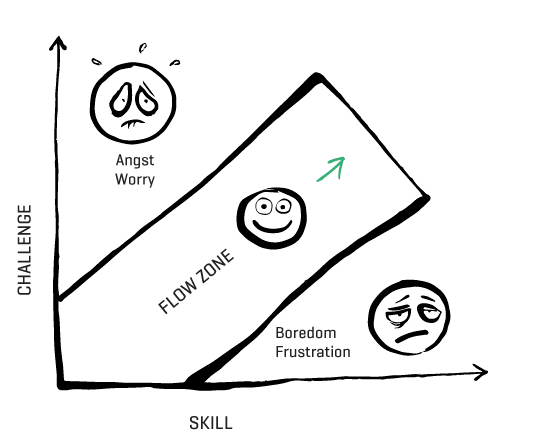
Figure 4.7 Flow zone
Students with higher learning potential may “drop out” if the teaching is perceived as trivial.67 Therefore the students always need new challenges. Academic challenges for this group of students does not mean that they must read an extra book, but that they are challenged to learn in other and more creative ways, for example by solving problems and working on more independent reading of the subject matter. More of the same is not a good way of being challenged.68
The analysis of the Student Survey from 2013 and 2014 indicates that several students on high levels are not given the academic challenges they need. They score low on the question relating to whether they are given sufficient academic challenges in school that covers both years. These responses only represent students who state that they achieve at a high level. Students with unexploited potential will not necessarily appear here. Nevertheless, this gives some indication that many students could have exploited their learning potential better if they were given greater academic challenges and more varied instruction.
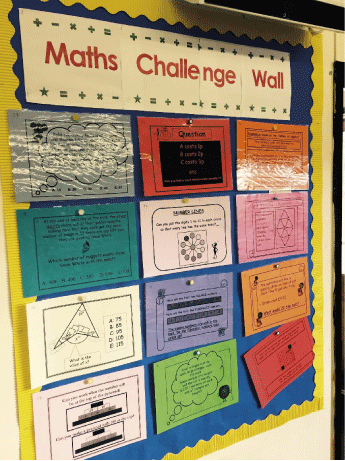
Figure 4.8 In Y Pant Comprehensive School in Cardiff, the teachers are working in different ways to give their students academic challenges. Here is an example from mathematics in lower secondary school where the students may choose tasks themselves.
Photo: The secretariat
This is consistent with analyses which show that schools that have developed a good learning environment also contribute to levelling out social differences. These analyses seem to suggest that schools that place high academic expectations on their students have weaker connections between student results and social background, but these findings are not as clear if several studies are collated.69
4.2.6 Assessment for learning
The teacher has to give feedback on how to develop even if I get a [top grade] 6! It's no fun to get: “Great, carry on the good work”. The teachers look more at the grades than what we have learnt to get a [top grade] 6, or how we may make progress.
Input from a student
Assessment for learning means that the teacher uses information about a student's progression and development to involve him or her in his or her own learning process. Using clear goals, relevant feedback in the subject and self-assessment, the students will become aware of their own strengths and what they need to work on more. Systematic use of formative assessment may also help the teacher to see progression and development, which forms the basis for giving the students academic challenges that are adapted to their abilities and aptitudes.70
Students with higher learning potential have considerable need for individual guidance where goals, feedback and self-reflection are in focus.71 The principles of formative assessment are thus very important in the efforts to provide differentiated instruction for students with higher learning potential. Several of the schools the Committee has visited which are concerned with differentiating the instruction for students with higher learning potential are working systematically with assessment for learning. This may indicate that the principles can be used to give both students and the teacher insight into where the students are and their learning potential. The analysis of the Student Survey 2013 and 2014 showed that students with good results master working with the principles of good formative assessment.72
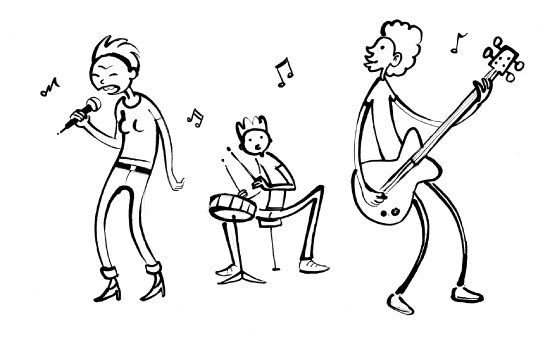
Figure 4.9
Evaluations from the project Forskning på individuell vurdering i skolen (FIVIS) [Research on individual assessment in school]73 indicate that there are challenges when it comes to instantiating the competence objectives. In many contexts, the instantiation of the goals may have made the competence objectives less visible for the teacher, and not least for the students. This in turn has consequences for what type of feedback the students are given, and the type of content they acquire.74 For students with higher learning potential who need to work in more creative and in-depth ways, it will be particularly important that the goals and feedback reflect their potential and performance and that they are not too specific. Using students' interests in the work with goals in the teaching is also important for the motivation of this group of students.75
The Committee finds that it is necessary to provide the opportunity to follow progression on high and advanced levels in the subjects in question. The Report to the Storting 28 (2015–2016) recommends that the progression in the subject curricula is made clear by developing guiding descriptors for the students' learning pathways in the subjects. The proposed progression descriptors in the guides for the subject curricula shall support the teachers' work to differentiate the instruction for individual students and groups of students. The Committee is in favour of this and considers it necessary to follow up all students in a better way, including those on high and advanced levels.
The Committee has not assessed whether the current grade scale has been sufficiently developed to describe competence on an advanced level. Whether this is a relevant aspect to include in the renewal of the Knowledge Promotion curriculum is a question left to those in charge of that work.
4.2.7 In-depth learning and interdisciplinary work
Many of us have heard the teacher say that we mustn't go so fast, then it becomes so boring when the rest of the class has to work on learning what we already know. But we don't always need to skip to the next stage. We could do tasks in some other way. Specialise, go in-depth into something. Add some questions, make the tasks a bit more complicated, be more creative! They could let us use other sources than the textbook.
Input from SkoleProffene
Working in-depth through enrichment is an important measure for students with higher learning potential.
Enrichment of the regular instruction is a measure that can be implemented within the classroom framework. Briefly put, this means expanding or elaborating on the subject matter.76 Enrichment refers to giving the students the opportunity to learn in-depth, but also more broadly, for example by working with topic areas or in an interdisciplinary way.77 In-depth study means the students are allowed to study and work with the subject matter over time, and that they receive feedback and challenges that keep pace with their development in the subject. It is also important for the learning that the students reflect on their own learning and are given help to understand how things hang together.78 Surface learning, in contrast to in-depth learning, means learning facts without putting the knowledge into a context.79 For students with higher learning potential, it might be constructive if they are encouraged to work in-depth so that they can acquire competence relating to learning more independently and are more able to regulate their own work.80
The importance of interdisciplinary work has been given special focus in NOU 2015: 8 Fremtidens skole [The school of the future], and is being followed up by a renewal of the subject curricula in Report to the Storting no. 28 (2015–2016). The teaching should stimulate competence and insight into topics across subject areas, and the students should work with issues or topics that require knowledge and skills from several subjects. Making this type of interdisciplinary work more visible may be a way to ensure students' in-depth learning.81 The Committee finds it positive for students with higher learning potential that in-depth and interdisciplinary learning are considered to be a key part of the subject renewal, precisely because these students may benefit a great deal from working with enrichment in subjects.82
We point out that less comprehensive subjects should not become synonymous with subject curricula with more restrictive competence objectives which lessen the opportunities for students with higher learning potential to work in-depth and over a broad scale, or narrow topics or the diversity of content.
The OECD report Art for Art's Sake?83 points out that instruction in art subjects puts focus on and stimulates both cognitive and non-cognitive knowledge and skills in students. This can help to improve students' holistic development and competence. This does not only apply to interdisciplinary work, but also to method transfer. What motivates students in one subject may also be motivating in other subjects. The report also shows that students actively engaged in music and other art disciplines show higher ambitions and achievements in other subjects. This also applies to students actively engaged in sports.84 In Denmark, in-depth studies were highlighted in connection with the Folkeskolereformen [Reform of primary and lower secondary school] in 2014, see Box 4.2.85
4.3 Summary and assessment
Based on research, input and experiences, the Committee finds that schools and teachers need more knowledge about what promotes learning for all students, and what students with higher learning potential require. International studies, such as the PISA surveys, show that students who achieve on high levels often have more stamina for task solving and better results in problem solving than students on lower levels. They need to have a learning environment that gives them the opportunity to develop these capacities and improve their achievements. The Committee believes that it is important that students with higher learning potential encounter a teaching practice that motivates them through the provision of challenging and creative tasks. In sports environments, concrete and understandable goals, focus on goals over time and a high level of self-control are seen as important ways of achieving good results. We believe that this is also particularly important for students with higher learning potential.
Textbox 4.2 In-depth learning and interdisciplinary work in Denmark
Teaching in the Danish “folkeskole” (primary and lower secondary school) must be differentiated so that its point of departure is the individual student's abilities and relevant development stages, and shall aim for what each student can achieve. This also applies to students with higher learning potential, who must be challenged and achieve even higher (In Denmark the term particularly gifted children is used.) Supportive instruction, found in section 16a of the Folkeskolelov [Act relating to primary and lower secondary school], shall provide the students with the opportunity to have in-depth studies in subjects and to work broadly with their abilities and interests.
Supportive teaching refers to learning activities that go beyond the regular subjects and topics of the primary and lower secondary school. It should create variation in everyday school and give academic challenges and opportunities for differentiation so that the instruction fits each student.
The activities in supportive teaching shall:
support instruction in the subjects and/or
strengthen the students personally through learning to learn, through social competence, versatile development, motivation and well-being.
In the supportive teaching, the students will be able to try out, train and develop skills and competences using activities such as reading training, mathematics exercises, homework assistance and in-depth studies. Student council activities, student performance review dialogues, movement and cooperation with the local sports, culture and association/club life and other activities which support the versatile development and motivation of the students may also be included in supportive teaching.
Source Danish Ministry for Children, Education and Gender Equality 2016, translated by the Committee
The fact that Norway has few students achieving on high and advanced levels suggests that there is a need to work on providing learning situations that promote student motivation for learning, and strengthen their self-regulated learning. Principles of good formative assessment may be useful in this work and may help the students to learn more about their own strengths and challenges. We believe there is a need to examine more closely how principles of good formative assessment may be linked to individual guidance for students with higher learning potential. If the students are to encounter challenges and work in-depth in their subjects, it is necessary to think flexibly and innovatively about educational methods and organisation of groups.
Footnotes
NOU 2015: 2 Å høre til [Belonging], p. 32
Idsøe 2014a, Sousa 2009
Dweck 2006
Cook and Bliss 2006, Whitlock and Moser 2009
Malabou 2009
Gaze and Taylor 1987, Malabou 2009
Dweck 2006
Freeman et al. 2010
OECD 2013
Renzulli 2005
Mönks 1992
Børte et al. 2016, Mönks 1992, Renzulli 2005
Renzulli 2005
Renzulli 2005
Nyström 2016
Mönks 1992, Renzulli 2005, Skogen and Smedsrud 2016
OECD 2013a
Sousa 2009
The principles are based on Dumont and Istance 2010, NOU 2014: 7 Elevenes læring i fremtidens skole [Pupil learning in the school of the future], OECD 2013a
Dumont and Istance 2010, NOU 2014: 7 Elevenes læring i fremtidens skole [Pupil learning in the school of the future], OECD 2013a
The Quality Framework
Ministry of Education and Research 2016a, Norwegian Directorate for Education and Training 2016b
Jang et al. 2010
Black et al. 2006, Gamlem 2015, Hattie and Timperly 2007, Wiliam 2015
Brandmo 2014
Hopfenbeck 2014
Dumont and Istance 2010, NOU 2014: 7 Elevenes læring i fremtidens skole [Pupil learning in the school of the future]
Hopfenbeck 2014
Nystrøm 2016, Renzulli 2005
Børte et al. 2016
Siegle 2013, Yang 2005
Olsen 2016
Hattie 2009, Nordenbo et al. 2008
Nordenbo et al. 2008
Aasen et al. 2014
Robinson 2014
Børte et al. 2016
Input from SkoleProffene
The book uses the term gifted children
Lie 2016
Børte et al. 2016
Mathisen and Olsen 2016
Freeman 1998, Idsøe 2014a
Clark 2012
Bakken 2010
Børte et al. 2016
Report to the Storting no. 22 (2010–2011), p. 13
Pintrich and Schunk 2002
Skogen 2014, Skogen and Smedsrud 2016
Fiskerstrand and Rimeslåtten 2009
Olsen and Skogen 2014
Olsen and Skogen 2014
Hopfenbeck 2014
Olsen and Skogen 2014
Feldhusen et al. 2000, Gottfried and Gottfried 1996
McCoach and Siegle 2008, Siegle et al. 2013
Moon 2012
NOU 2015: 8 Fremtidens skole [The school of the future], p. 34
Hopfenbeck and Roe 2010
Clark 2012
Dælien and Eriksen 2015
Greeno 2006
Vygotsky 1996
Csikszentmihaly 1996
Olsen and Skogen 2015
Csikszentmihaly 1996
Børte et al. 2016
Idsøe 2014a, Skogen and Smedsrud 2016
Bakken 2014
Black et al. 2006, Wiliam 2015
Gross 2004, Heller et al. 2005, Skogen 2014, Skogen and Smedsrud 2016
Wendelborg and Caspersen 2016
FIVIS is the Norwegian abbreviation for research on individual assessment in school. This was a cooperative project between the Norwegian University of Science and Technology and SINTEF on assignment from the Norwegian Directorate for Education and Training
Sandvik and Buland 2014
Gross 2004
Idsøe 2014a, Renzulli 2005, Skogen and Smedsrud 2016
Renzulli 2005
Skogen and Smedsrud 2016
Report to the Storting 28 (2015–2016)
Renzulli 2005
NOU 2015: 8. Fremtidens skole [The school of the future]
Idsøe 2014a, Renzulli 2005
Winner et al. 2013
Winner et al. 2013
Ministry for Children, Education and Gender Equality 2016